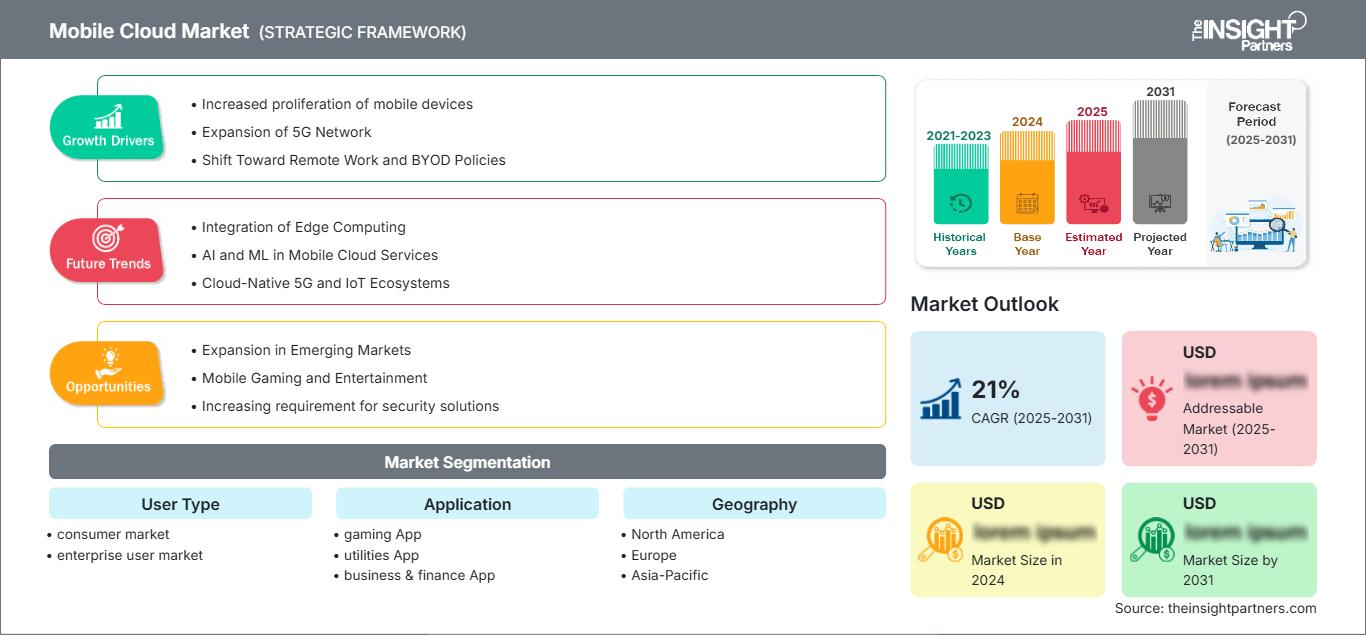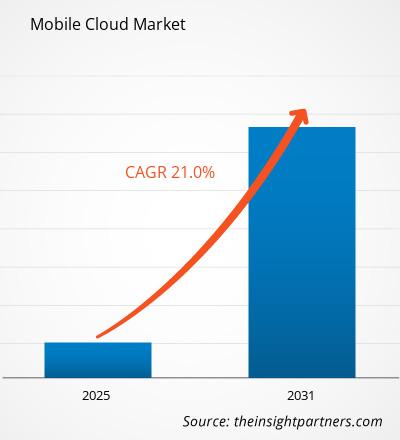Se espera que el tamaño del mercado de la nube móvil alcance los 87.050 millones de dólares estadounidenses para 2031. Se prevé que registre una tasa de crecimiento anual compuesta (TCAC) del 19,3 % entre 2025 y 2031.
El informe del mercado de la nube móvil abarca un análisis por tipo de usuario y aplicación. El análisis global se desglosa a nivel regional y por países principales. El informe ofrece información en dólares estadounidenses para el análisis y los segmentos mencionados.
Propósito del Informe
El informe "Mercado de la Nube Móvil" de The Insight Partners busca describir el panorama actual y el crecimiento futuro, los principales factores impulsores, los desafíos y las oportunidades. Esto proporcionará información a diversos actores del sector, como:
- Proveedores/fabricantes de tecnología: Para comprender la dinámica cambiante del mercado y conocer las oportunidades potenciales de crecimiento, lo que les permitirá tomar decisiones estratégicas informadas.
- Inversores: Realizar un análisis exhaustivo de tendencias respecto a la tasa de crecimiento del mercado, las proyecciones financieras del mercado y las oportunidades que existen en toda la cadena de valor.
- Órganos reguladores: Regular las políticas y las actividades policiales en el mercado con el objetivo de minimizar el abuso, preservar la confianza de los inversores y defender la integridad y estabilidad del mercado.
Segmentación del mercado de la nube móvil por tipo de usuario
- mercado de consumo
- mercado de usuarios empresariales
Solicitud
- Aplicación de juegos
- Aplicación de utilidades
- Aplicación de negocios y finanzas
- Aplicación de productividad
- Aplicación de atención médica
- Aplicación de entretenimiento
- aplicación de viajes y navegación
- Aplicación educativa
- Aplicaciones de redes sociales y otras
Obtendrá personalización en cualquier informe, sin cargo, incluidas partes de este informe o análisis a nivel de país, paquete de datos de Excel, así como también grandes ofertas y descuentos para empresas emergentes y universidades.
Mercado de la nube móvil: perspectivas estratégicas

-
Obtenga las principales tendencias clave del mercado de este informe.Esta muestra GRATUITA incluirá análisis de datos, desde tendencias del mercado hasta estimaciones y pronósticos.
Factores que impulsan el crecimiento del mercado de la nube móvil
- Aumento de la proliferación de dispositivos móviles: El uso de teléfonos inteligentes, tabletas e Internet de las Cosas (IoT) acelera significativamente el crecimiento del mercado de la nube móvil. Con la creciente dependencia de los dispositivos móviles tanto para el trabajo personal como profesional, la demanda de servicios en la nube está en aumento. Las soluciones en la nube deben ser escalables y seguras, requisitos fundamentales que se aceleran gracias a la facilidad de una sincronización perfecta entre plataformas y a la creciente penetración del internet móvil.
- Expansión de la red 5G: El despliegue global de la red 5G revoluciona considerablemente las capacidades de la nube móvil. La alta velocidad y la menor latencia, así como la mayor fiabilidad del 5G, permiten el procesamiento en tiempo real y el rendimiento de las aplicaciones móviles en la nube. Las empresas también pueden implementar aplicaciones más complejas en la nube gracias al 5G, lo que facilitará la innovación en los sectores de la salud, la educación y la manufactura.
- Transición hacia el teletrabajo y las políticas BYOD: La creciente tendencia al teletrabajo y a la práctica de traer su propio dispositivo exige el crecimiento de las nubes móviles. Las organizaciones están adoptando cada vez más tecnologías de nube móvil, al tiempo que apoyan a la fuerza laboral dispersa, ya que las personas ahora pueden acceder de forma segura a aplicaciones y datos empresariales desde cualquier dispositivo personal. Las soluciones de nube móvil garantizan productividad, colaboración y una seguridad robusta con almacenes de datos centralizados, sincronización en tiempo real y estrictos controles de acceso. El auge del teletrabajo, acelerado por la pandemia de COVID-19, ha subrayado aún más la importancia de la tecnología de nube móvil para mantener la continuidad y la flexibilidad del negocio. A medida que las empresas se centran en la movilidad de la fuerza laboral y la eficiencia operativa, se espera que aumente la adopción de soluciones de nube móvil.
Tendencias futuras del mercado de la nube móvil
- Integración de Edge Computing: Ante la creciente evolución de los servicios móviles en la nube, el edge computing se posiciona como una de las tendencias más significativas. Este sistema implica el procesamiento de datos cerca de la fuente de datos, o en este caso, del dispositivo móvil, en lugar de depender de servidores centralizados en la nube. Esto implica una latencia relativamente reducida y aplicaciones en tiempo real como vehículos autónomos, automatización industrial y ciudades inteligentes obtienen un mejor rendimiento en tareas urgentes.
- IA y ML en servicios móviles en la nube: Con el paso del tiempo, la IA y el ML transformarán el espacio de la nube móvil y permitirán a las organizaciones desarrollar aplicaciones inteligentes y automatizar diversas operaciones para diversos procesos de negocio. Los proveedores de la nube integrarán cada vez más la IA y el ML para funciones como análisis en tiempo real, mantenimiento predictivo y gestión inteligente de datos. La IA en combinación con la nube impulsará las innovaciones en los sectores de la salud, las finanzas y el marketing.
- Ecosistemas nativos de la nube 5G e IoT: Esta convergencia real de la primera generación de tecnologías 5G, IoT y de nube móvil crea un nuevo ecosistema de comunicación fluida entre dispositivos e intercambio de datos. Sus redes de alta velocidad y baja latencia serán 5G, diseñadas para facilitar el funcionamiento del IoT en entornos reales, desde hogares inteligentes hasta coches conectados. Por supuesto, será la nube, procesando, almacenando y analizando miles de millones de señales emitidas por dispositivos compatibles con IoT, el desarrollo de nuevas ciudades inteligentes, los sistemas de salud conectados y las soluciones de transporte de última generación.
Oportunidades del mercado de la nube móvil
- Expansión en mercados emergentes: La creciente penetración de los teléfonos inteligentes y la disminución del costo del acceso a internet móvil en las economías emergentes brindarán la mayor oportunidad de crecimiento en la nube móvil. Las empresas podrán ingresar a mercados con poca penetración ofreciendo servicios en la nube optimizados para el uso móvil a costos significativamente menores, impulsando así la transformación digital y el crecimiento económico. La infraestructura y las soluciones en la nube localizadas, preparadas para las necesidades regionales, abrirán nuevas fuentes de ingresos para los proveedores de servicios en la nube.
- Juegos y entretenimiento para móviles: Los juegos para móviles son un sector en crecimiento que incluye los juegos en la nube, un sector en rápido crecimiento impulsado por las tendencias del 5G y la computación en la nube. Servicios como Microsoft xCloud y Google Stadia cambiarán el paradigma del acceso a juegos de alto rendimiento en dispositivos móviles, dejando de depender de hardware costoso. Los servicios de streaming de vídeo y música, parte de las plataformas de entretenimiento móvil en la nube, también crecerán gracias a la búsqueda de soluciones escalables que puedan adaptarse al creciente tráfico de los desarrolladores de contenido.
- Necesidad creciente de soluciones de seguridad: A medida que aumenta la dependencia de los servicios móviles en la nube, crece la demanda de soluciones de seguridad más robustas. Dado que ahora se almacenan y se accede a datos y aplicaciones sensibles en dispositivos móviles, el riesgo de ciberataques es mayor. Existe la posibilidad de una mayor demanda a medida que las personas se inclinan más por la seguridad en la nube móvil, por lo que se encuentran empresas especializadas en este ámbito: cifrado, autenticación multifactor y gestión de identidad.
Perspectivas regionales del mercado de la nube móvil
Los analistas de The Insight Partners han explicado detalladamente las tendencias y los factores regionales que influyen en el mercado de la nube móvil durante el período de pronóstico. Esta sección también analiza los segmentos y la geografía del mercado de la nube móvil en Norteamérica, Europa, Asia Pacífico, Oriente Medio y África, y Sudamérica y Centroamérica.
Alcance del informe del mercado de la nube móvil
| Atributo del informe | Detalles |
|---|---|
| Tamaño del mercado en 2024 | XX mil millones de dólares estadounidenses |
| Tamaño del mercado en 2031 | US$ 87.05 mil millones |
| CAGR global (2025-2031) | 19,3% |
| Datos históricos | 2021-2023 |
| Período de pronóstico | 2025-2031 |
| Segmentos cubiertos |
Por tipo de usuario
|
| Regiones y países cubiertos |
América del norte
|
| Líderes del mercado y perfiles de empresas clave |
|
Densidad de actores del mercado de la nube móvil: comprensión de su impacto en la dinámica empresarial
El mercado de la nube móvil está creciendo rápidamente, impulsado por la creciente demanda de los usuarios finales debido a factores como la evolución de las preferencias de los consumidores, los avances tecnológicos y un mayor conocimiento de los beneficios del producto. A medida que aumenta la demanda, las empresas amplían su oferta, innovan para satisfacer las necesidades de los consumidores y aprovechan las tendencias emergentes, lo que impulsa aún más el crecimiento del mercado.

- Obtenga una descripción general de los principales actores clave del mercado de la nube móvil
Puntos clave de venta
- Cobertura integral: el informe cubre exhaustivamente el análisis de productos, servicios, tipos y usuarios finales del mercado de nube móvil, proporcionando un panorama holístico.
- Análisis de expertos: el informe se compila con base en el conocimiento profundo de expertos y analistas de la industria.
- Información actualizada: El informe asegura relevancia comercial debido a su cobertura de información reciente y tendencias de datos.
- Opciones de personalización: este informe se puede personalizar para satisfacer los requisitos específicos del cliente y adaptarse adecuadamente a las estrategias comerciales.
Por lo tanto, el informe de investigación sobre el mercado de la nube móvil puede ayudar a descifrar y comprender el panorama de la industria y sus perspectivas de crecimiento. Si bien existen algunas preocupaciones válidas, las ventajas generales de este informe tienden a superar las desventajas.
- Análisis histórico (2 años), año base, pronóstico (7 años) con CAGR
- Análisis PEST y FODA
- Tamaño del mercado, valor/volumen: global, regional y nacional
- Industria y panorama competitivo
- Conjunto de datos de Excel
Informes recientes
Informes relacionados
Testimonios
Razón para comprar
- Toma de decisiones informada
- Comprensión de la dinámica del mercado
- Análisis competitivo
- Información sobre clientes
- Pronósticos del mercado
- Mitigación de riesgos
- Planificación estratégica
- Justificación de la inversión
- Identificación de mercados emergentes
- Mejora de las estrategias de marketing
- Impulso de la eficiencia operativa
- Alineación con las tendencias regulatorias






















 Obtenga una muestra gratuita para - Mercado de la nube móvil
Obtenga una muestra gratuita para - Mercado de la nube móvil